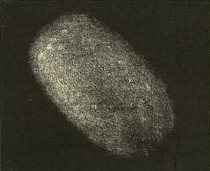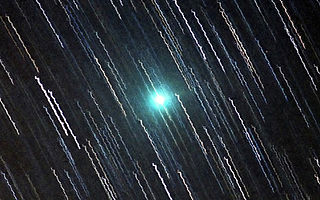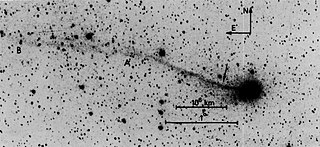Related Research Articles

5D/Brorsen was a periodic Jupiter-family comet discovered on February 26, 1846, by Danish astronomer Theodor Brorsen. The comet was last seen in 1879 and is now considered lost.

Comet IRAS–Araki–Alcock is a long-period comet that, in 1983, made the closest known approach to Earth of any comet in the last 200 years, at a distance of about 0.0312 AU.
Comet C/1861 G1 (Thatcher) is a long-period comet with roughly a 422-year orbit that is expected to return around 2283. It was discovered by A. E. Thatcher. It is responsible for the April Lyrid meteor shower. Carl Wilhelm Baeker also independently found this comet. The comet passed about 0.335 AU from the Earth on 5 May 1861 and last came to perihelion on 3 June 1861.
255P/Levy, formerly P/2006 T1 and P/2011 Y1, is a periodic comet with an orbital period of 5.25 years. It last came to perihelion on 14 January 2012. During the 2006 passage the comet achieved an apparent magnitude of ~9.5. Levy (PK06T010) was believed to have been recovered on 3 June 2011 at magnitude 19.8, but other observatories were unable to confirm a recovery. It was most likely a false positive because of large residuals. Levy was recovered on 17 December 2011 at magnitude 19.8, and given the second designation 2011 Y1. It was then numbered.

209P/LINEAR is a periodic comet with an orbital period of 5.1 years. The comet has extremely low activity for its size and is probably in the process of evolving into an extinct comet.

249P/LINEAR is a periodic Jupiter-family comet with an orbital period of 4.61 years. It was discovered by LINEAR on 19 October 2006. It is only active for a brief period around perihelion.

C/1979 Y1 (Bradfield), also known as Comet 1979X and 1979l, is a long period comet discovered by William A. Bradfield on 24 December 1979. The comet has an orbital period of 308 ± 6 years and last passed perihelion on 21 December 1979. It is considered to be the parent body of the July Pegasids meteor shower. It is expected to next come to perihelion around 2287.
C/1917 F1 (Mellish), also known as Comet 1917Ι and 1917a, is a Halley-type comet discovered by John E. Mellish on 19 March 1917. The comet has an orbital period of 143 years and last passed perihelion on 11 April 1917. It is the parent body of the December Monocerotids and has also been suggested to be the parent body of daytime kappa Leonids, April ρ-Cygnids, November Orionids, and Canis-Minorids meteor showers.

C/1939 H1 (Jurlof–Achmarof–Hassel) is a long-period comet discovered on 15 April 1939. The comet was discovered by many observers independently but the first reports were those of Olaf Hassel, Achmarof, and Jurlof. The comet had a magnitude of 3 upon discovery.

C/1911 N1 (Kiess) is a non-periodic comet discovered by Carl Clarence Kiess on 6 July 1911. The comet has been identified as the parent body of the Aurigids meteor shower.

C/1907 G1 (Grigg–Mellish) is a long-period comet discovered independently by John Grigg and John E. Mellish in April 1907. The comet has been identified as the parent body of the delta Pavonids meteor shower.

C/1961 T1 (Seki) is a long-period comet discovered by Tsutomu Seki on 10 October 1961. The comet has been identified as the parent body of the December ρ-Virginids meteor shower.
C/1975 T2 (Suzuki–Saigusa–Mori) is a long-period comet discovered on 5 October 1975. The comet approached Earth at a distance of 0.1 AU on 31 October 1975 and became visible with naked eye. The comet has been associated with the lambda Ursae Majorids meteor shower.
C/1983 J1 (Sugano–Saigusa–Fujikawa) is a non-periodic comet discovered by Matsuo Sugano, Yoshikazu Saigusa, and Shigehisa Fujikawa on 8 May 1983. The comet approached Earth at a distance of 0.063 AU on 12 June 1983.
C/1739 K1 is a non-periodic comet that was discovered by Italian astronomer Eustachio Zanotti in 1739. It is the parent body of the Leo Minorids meteor shower.

C/1948 L1 (Honda–Bernasconi) is a non-periodic comet discovered on 3 June 1948. The comet was discovered by Minoru Honda and independently found by Giovanni Bernasconi the next day.
Comet Haneda–Campos, formally designated as D/1978 R1, was a periodic comet with a 5.97-year elliptical orbit around the Sun. It was never successfully recovered during its 1984 and 1991 apparitions, and is now considered lost.
Chacornac's Comet, formally designated as C/1852 K1, is a faint parabolic comet that was observed through telescopes between May and June 1852. It is the only comet discovered by French astronomer, Jean Chacornac, and is the parent body of the Eta Eridanids meteor shower.
C/1853 G1 (Schweizer) is a long period comet discovered by Kaspar Gottfried Schweizer on 5 April 1853. The comet has an orbital period of about 780 years and has been associated with two weak meteor showers.
C/1864 N1 (Tempel) is a non-periodic comet discovered by Wilhelm Tempel on 5 July 1864. It was the first comet whose spectrum was analysed.
References
- ↑ "C/1864 N1 (Tempel) – JPL Small-Body Database Lookup". ssd.jpl.nasa.gov. Jet Propulsion Laboratory . Retrieved 3 January 2025.
- ↑ P. Jenniskens; D. S. Lauretta; M. C. Towner; S. Heathcote; E. Jehin; et al. (2021). "Meteor showers from known long-period comets". Icarus . 365: 114469. doi:10.1016/j.icarus.2021.114469.
- 1 2 3 G. W. Kronk (2003). Cometography: A Catalog of Comets. Vol. 2: 1800–1899. Cambridge University Press. pp. 165–166. ISBN 978-0-521-58505-7.
- ↑ Greaves, John (1 February 2012). "Four Meteor Showers from the SonotaCo Network Japan". WGN, Journal of the International Meteor Organization. 40: 16–23. ISSN 1016-3115.
- ↑ Šegon, Damir; Andreić, Željko; Korlević, Korado; Novoselnik, Filip; Vida, Denis; Skokić, Ivica (1 June 2013). "8 new showers from Croatian Meteor Network data". WGN, Journal of the International Meteor Organization. 41: 70–74. ISSN 1016-3115.
- ↑ Shiba, Yasuo; Ueda, Masayoshi (1 February 2013). "December Sigma-Virginids". WGN, Journal of the International Meteor Organization. 41: 7–10. ISSN 1016-3115.

